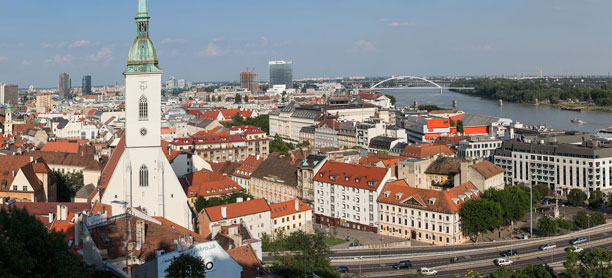Bratislava – Twin City

Alexander Russy, CC BY 2.0
If you think of a Twin City, what comes to your mind is probably Tolkien’s Minas Tirith and its evil counterpart Minas Morgul. Well, Vienna has a twin city too, but unlike Sauron’s dark fortress Bratislava is rather an unknown treasure, amongst European capitals, than Vienna’s evil equivalent.
The Slovakian capital is one of these places, everybody (in Vienna) means to go, but hardly ever do. Which is a shame, because Bratislava makes up for a wonderful daytrip due to its short distance to Vienna. 55 to 70 kilometers (depending on your means of transportation), Bratislava finds itself at the shores of the Danube, with a beautiful old town and a medieval fortress waiting to be explored. With a population of 420.000 people the city formerly known as Pressburg, is by far the second largest city in the area. In spite of its size the city has an intimate and familiar feeling to it that is usually found in smaller towns.
Bratislava is equally occupying both banks of the Danube, but most historical buildings and beautiful infrastructure are located in the northern half in Old town. The central district is defined by 19th century architecture and historical palaces and buildings. Its most famous attractions are Bratislava’s castle on a hill at the center of the city, the town hall, a three building complex, which also contains the city museum and the Gothic St. Martins Cathedral right in the center. Modern architecture can be found at the Most Slovenského národného povstania (Bridge of the Slovak national uprising – abr. Novi Most) across the Danube featuring a UFO-like tower restaurant, Slovak Radio’s inverted-pyramid-shaped building complex, and the futuristic Kamzík TV Tower with an observation deck and rotating restaurant.
It’s too easy
What makes Bratislava the perfect destination for Viennese visitors is, how easy it is to get there (and back). Next to the highway, you can get there by bus or train within an hour. And if you want to spice things up you can book a boat ride down the Danube via the Twin City Liner, departing multiple times per day from Schwedenplatz. The fares for train and bus are around 10 Euros, the boat ride costs a little more.
Since 11 years Slovakia is part of the European Union, which makes travelling to Bratislava an institutional Breeze. The Slovaks also adopted the Euro in 2009, in order that money exchange is also not a problem. Speaking of money, Slovakian gastronomy taxes are much lower compared to Austria, which leads to prices, which are around 40-50% lower than we are used to.
There are hundreds of reasons, why a Bratislava visit is worth its while, either to explore the cultural, the culinary and the aesthetic side of Slovakia’s capital, not to mention its club scene (GER). Need more inspiration?

post a comment
You must be logged in to post a comment.